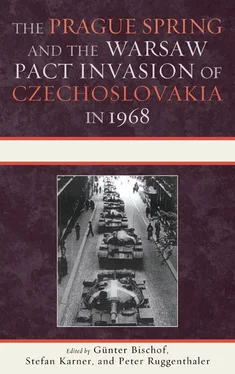The years 1975 to 1977 proved to be crucial in this particular respect: facing the threat of reformed Western communism, U.S. diplomacy renounced direct confrontation and instead adopted its most subtle approach to date, drawing, through the emerging G-7 summits, a concert of powers aimed at forging a socioeconomic consensus around the restoration of laissezfaire principles. This included the cooption of social democratic forces in France, Germany, and Italy. Both the French and the Italian Communists for the most part continued to rely on neo-Keynesian recipes. While this confirmed their cultural and economic adaptation to neocapitalism, it also showed their detachment from the realities of international economics and diplomacy that took shape under the influence of Kissinger and German chancellor Helmut Schmidt. 90A restored laissez-faire policy, while temporary, was the dream of neither the Prague nor the Paris rebels. Most of Italy’s Communists, converging into the establishment of the new Party of the Democratic Left at the end of the Cold War, at best strove for a capitalism with a human face.
1. Gianfranco Corsini, “Marilyn tra mito e verità,” Rinascita , 11 August 1962; JeanMarc Aucuy, “Hommage a Marilyn Monroe ou le decolonisation par l’erotisme,” Nouvelle Critique 140 (November 1962); Gianfranco Corsini, “Marilyn e gli intellettuali,” Rinascita , 8 September 1962; see also “‘Miller: Mia moglie è geniale; Marilyn: mio marito è matto’: Intervista con i due,” Vie Nuove , 23 April 1960.
2. For background, see especially Philippe Roger, The American Enemy: The History of French Anti-Americanism (Chicago: University of Chicago Press, 2005); Jessica C. E. Gienow-Hecht, “Always Blame the Americans: Anti-Americanism in Europe in the Twentieth Century,” American Historical Review 111, no. 4 (October 2006): 1067–91; Herbet J. Spiro, “Anti-Americanism in Western Europe,” Annals of the American Academy of Political and Social Sciences 497 (May 1988): 120–32; David W. Ellwood, ‘The American Challenge Renewed: U.S. Cultural Power and Europe’s Identity Debates,” Brown Journal of World Affairs , Winter/Spring 1997; Federico Romero, “Americanization and National Identity: The Case of Postwar Italy,” in Europe, Its Borders and the Others , ed. Luciano Tosi (Napoli: ESI, 2000); David Strauss, Menace in the West: The Rise of French Anti-Americanism in Modern Times (Westport, CT: Greenwood, 1978); Nemici per la pelle . Sogno americano e mito sovietico nell’Italia contemporanea , ed. Pier Paolo D’Attorre (Milan: F. Angeli, 1991).
3. Cf. Ilya Ehrenburg, “Non potete capirci niente se dimenticate che è un paese giovane,” L’Unità , 18 August 1946; Italo Calvino, “Petrov e Ilf in America,” L’Unità , 23 March 1946; Marcello Flores, L’immagine dell’URSS: L’Occidente e la Russia di Stalin (1927–1956) (Milan: Il Saggiatore, 1990), 343–48.
4. Antonio Gramsci, “Americanism and Fordism,” in Selections from the Prison Notebooks , ed. and trans. Quintin Hoare and Geoffrey Nowell Smith (London: Lawrence and Wishart, 1971); see also Antonio Gramsci, Note sul Machiavelli, sulla politica e sullo stato moderno (Turin: Einaudi, 1955), 329–40.
5. Quoted Calvino, “Hemingway e noi,” Il Contemporaneo , 13 November 1954, pp. 3, 5; cf. Nello Ajello, Intellettuali e PCI , 1944–1958 (Bari: Laterza, 1979), 14; Patrick McCarthy, “America: L’altro mito della cultura comunista,” in D’Attorre, Nemici per la pelle , 222–23.
6. Claude Roy, “Le ciel est ma frontière,” Les Lettres Françaises , 1 November 1946.
7. Cesare Pavese, La letteratura americana, e altri saggi , 3rd. ed. (Turin: Einaudi, 1959), 194; see also Elio Vittorini, Diario in pubblico , 2nd ed. (Milan: Bompiani, 1957), 234; Michele Bottalico, “A Place for All: Old and New Myths in the Italian Appreciation of American Literature,” in As Others Read Us: International Perspectives on American Literature , ed. Huck Gutman (Amherst: University of Massachusetts Press, 1991). Ingrao qtd. in McCarthy, “America: L’altro mito,” 223.
8. Pavese, La letteratura americana , 196.
9. Report Commissione Culturale Nazionale, November 1953, 5; and Report Salinari, in Report Commissione Culturale Nazionale, November 1953, 33, Commissione Cultura, Archivio del Partito Comunista Italiano, Istituto Gramsci, Rome, Italy (hereafter APCI).
10. Quoted Mtg. Direzione, 20 June 1956, Verbali Direzione (hereafter VD), mf 198, APCI. On Clare Luce in Italy, see also Mario Del Pero, “American Pressures and Their Containment in Italy during the Ambassadorship of Clare Boothe Luce, 1953–56,” Diplomatic History 28, no. 3 (June 2004): 407–39; and Alessandro Brogi, L’Italia e l’egemonia americana nel Mediterraneo (Florence: La Nuova Italia, 1996), chaps. 2, 3, and 4.
11. Quoted Stephen Gundle, Between Hollywood and Moscow: The Italian Communists and the Challenge of Mass Culture, 1943–1991 (Durham, NC: Duke University Press, 2000), 90 (Berlinguer also qtd. ivi; see also 80); quoted Amendola and Romagnoli in Mtg. Direzione 28 February 1962, VD, APCI.
12. Decision Bureau Politique (hereafter Dec. BP) 24 May 1962, Archives du Parti Communiste Français, Seine-Saint-Denis, Paris, France (APCF). Quoted D. S. Bell and Byron Criddle, The French Communist Party in the Fifth Republic (Oxford: Oxford University Press, 1994), 220; cf. Marc Lazar, “Le Réalisme socialiste aux couleurs de la France,” L’Histoire 45 (March 1982): 60ff; Roger Martelli, “De Gaulle et les communistes entre traditions et modernité,” in 50 ans d’une passione française: De Gaulle et les communistes , ed. Stephane Courtois and Marc Lazar (Paris: Balland, 1991).
13. Quoted John L. Gaddis, The Cold War: A New History (New York: Penguin, 2005), 77; quoted Eric Shiraev and Vladislav Zubok, Anti-Americanism in Russia from Stalin to Putin (New York: Palgrave, 2000), 13–14.
14. Lefranc, “Le nouveau nouveau monde,” Democratie nouvelle (March 1961): 74; Jacqueline Vernes, “Les USA face au défi économique de l’URSS,” Democratie nouvelle (July 1960): 54–61; Jean Bruteau, “Problemes de l’automatisation,” La Nouvelle Critique (September/October 1957): 21–34; Nicola Sarzano, “Siamo tutti Rockefeller,” Vie Nuove , 5 March 1964; Carlo Marcucci, “Le quattro lezioni dei giochi,” Vie Nuove , 17 September 1960; Antoine Casanova, “La doctrine sociale de l’Eglise et le marxisme,” La Nouvelle Critique 141 (December 1962). Attributing a corporatist outlook to Catholic reformism, see Bruno Trentin in meeting 28 February 1962, VD, APCI; see also Alfredo Reichlin a Segreterie, Federazioni e Comitati Regionali, 22 August 1962, Sezione Stampa e Propaganda (hereafter SSP), MF 494, APCI.
15. Marc Lazar, Maisons rouges: Les Partis communistes français et italien de la Libération à nos jours (Paris: Aubier, 1992), 73, see also 18–27, 329–40. Cf. Elena Aga Rossi and Gaetano Quagliarello, L’altra faccia della luna: I rapporti tra PCI, PCF e Unione Sovietica (Bologna: Il Mulino, 1997), 51–78. Cf. traditional accounts emphasizing differences, especially Thomas H. Greene, “The Communist Parties of Italy and France: A Study in Comparative Communism,” World Politics 26 (October 1968): 4; Donald L. M. Blackmer and Sidney Tarrow, eds., Communism in Italy and France (Princeton, NJ: Princeton University Press, 1975), especially the chapter by Sidney Tarrow, “Communism in Italy and France: Adaptation and Change.” See also Cyrille Guiat, The French and Italian Communist Parties: Comrades and Culture (London: Frank Cass, 2003).
Читать дальше












